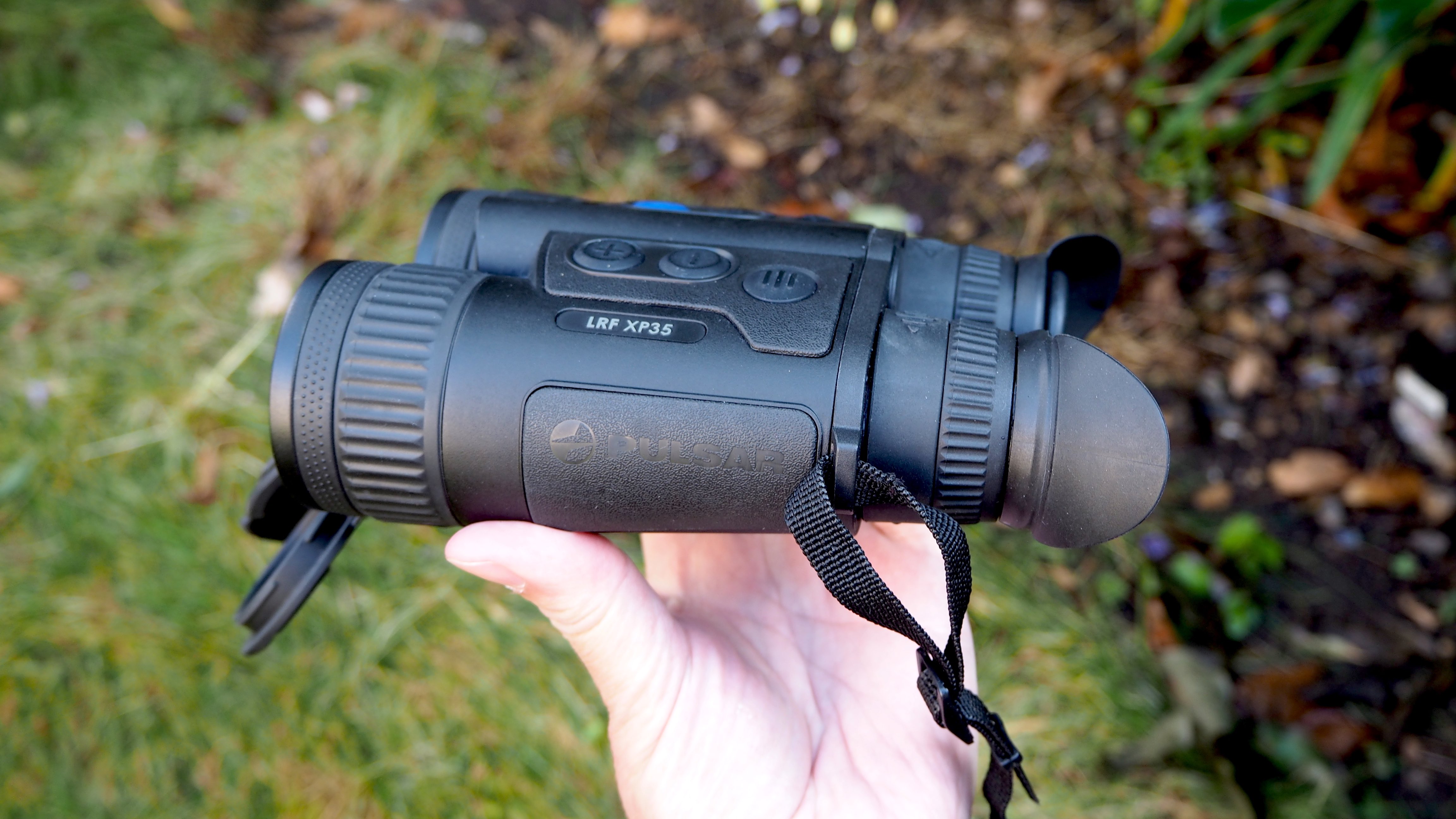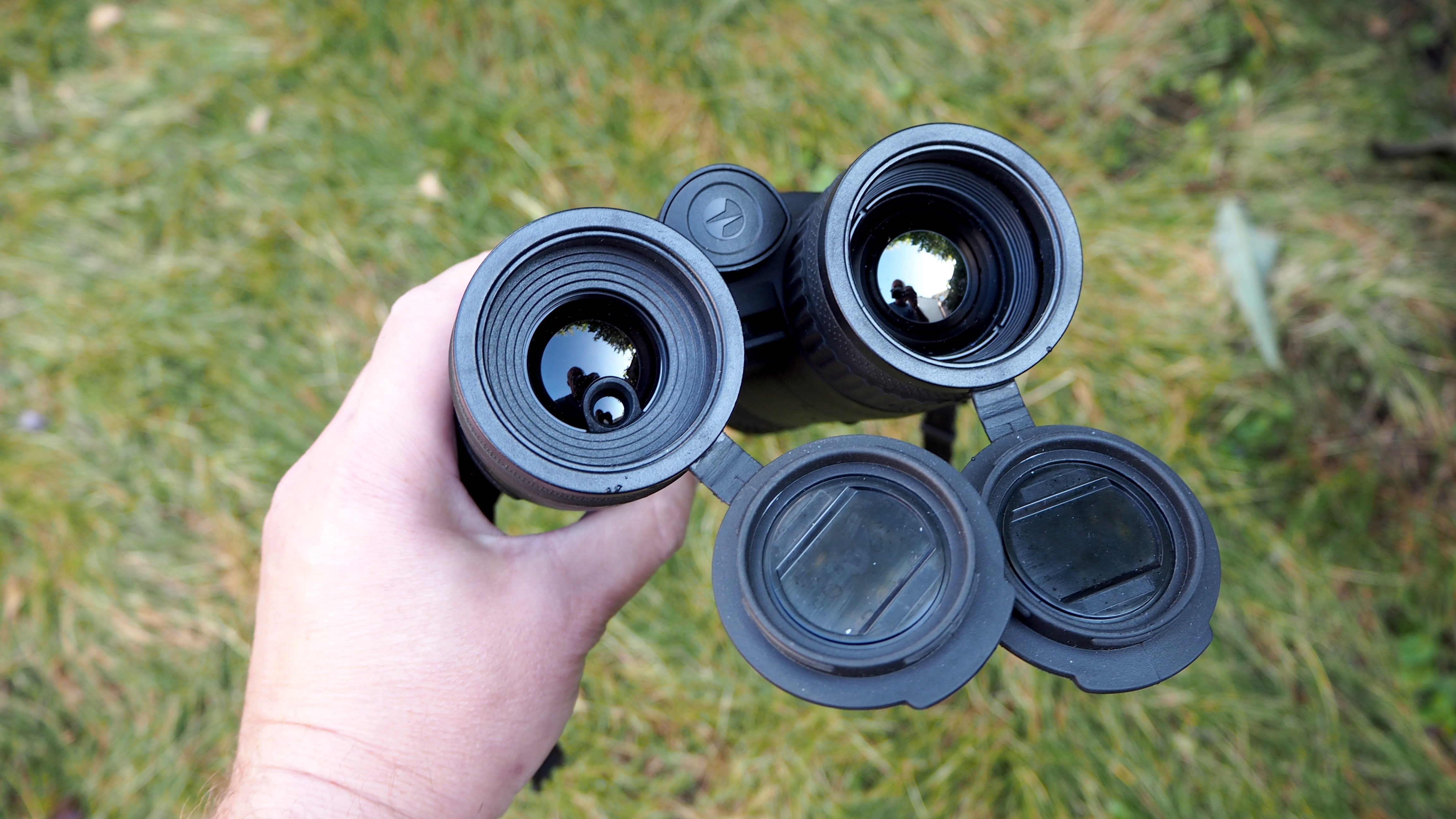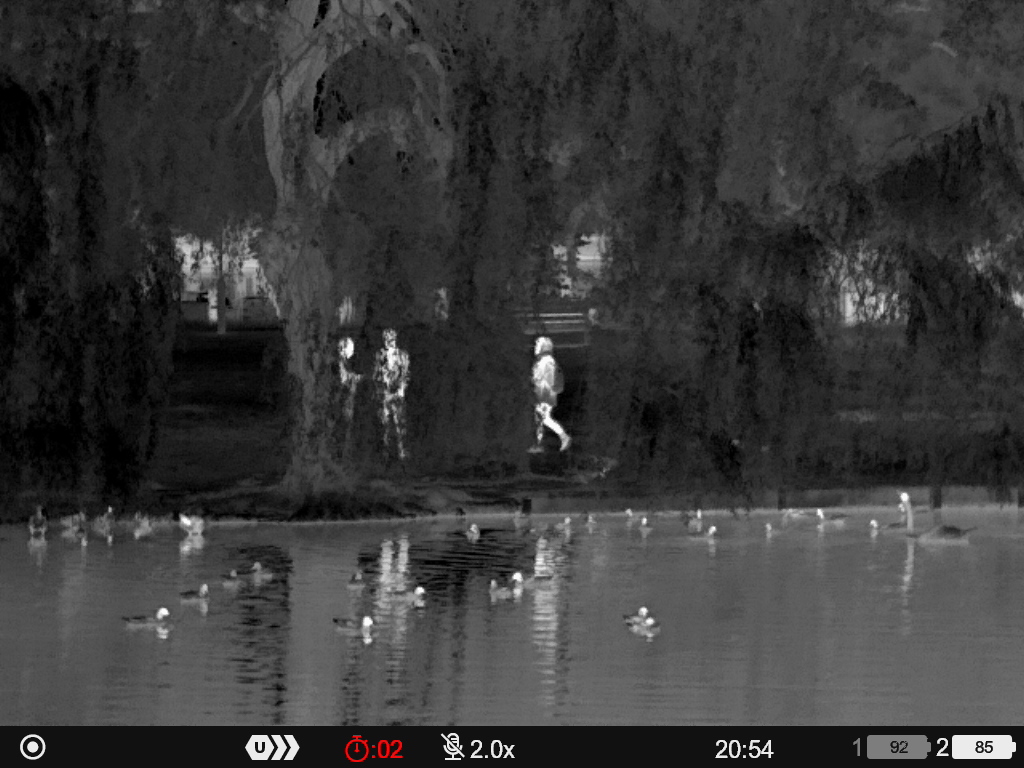Digital Camera World Verdict
New to market at the time of writing, boasting a 640x480 pixels standard resolution sensor and a 1350 meter detection range, this solid feel, rubber-coated binocular with built-in zoom capacity is the entry-level option in its maker’s lineup for 2024 when it comes to spotting and observing subjects in the dark. With a solid feel build and a feature-packed spec, after a period of familiarisation, it quickly becomes fun to use not to mention fast and accurate in determining not only where a subject might be in the dim thanks to their heat trace, but also, potentially invaluably, how far from us in meters they are. The only downside is the tech on offer means this specialist device costs as much as some second-hand cars.
Pros
- +
Rubber coated magnesium alloy body aids grip
- +
IPX7 level of waterproofing
- +
External/internal battery combo lasts up to 9 hours
- +
16GB internal memory
- +
Built-in zoom proves useful in pinpointing subjects
- +
Comfortable, padded, and supportive neck strap provided
Cons
- -
Very expensive compared to standard, non-thermal binoculars
- -
Weightier and bulkier than less tech-packed alternatives
Why you can trust Digital Camera World
Although in our minds we may more readily associate them with the military, special forces, or even sci-fi movies, thermal imaging binoculars are designed to see what we can’t ordinarily. And being a specialist and niche tool even for us civilians, inevitably comes with an expectedly large price tag, compared with ordinary optical, non-battery-powered binoculars.
Still, with its rubberized exterior and six large penny-sized buttons that fall within reach of the fingertips of each hand when the device is gripped and held steady, it’s quickly clear the Pulsar Merger LRF XP35 is not just your average bog standard bino.
In fact, it’s worth noting that thermal imaging binoculars such as this example not only give us a brighter image in dim light but actively pick up the heat trace of a subject that might otherwise be hidden or partially obscured. Humans and animals are of course generally warmer than their surroundings, so a thermal imaging sensor has the advantage of being able to pick them out, even where natural or man-made obstructions would normally obscure our view.
As those in the know will be aware, more tech not only means a higher cost but, typically also a bulkier and weightier binocular. A little bit of weight, however, can sometimes be an advantage, meaning they sit steadier in the hand for a more comfortable, wobble-free view when used without a tripod.
Usefully, a screw is provided on the base of this model for a supplied tripod adapter to be attached, so we have the luxury of hand-held use or tripod-mounting options at our disposal here.
So, with all this in mind, how do the Pulsar Merger LRF XP35 thermal imaging binoculars work out in practice? Read on to find out…
Pulsar Merger LRF XP35: Specifications
| Magnification | 2-16x |
| Objective lens | 35mm f/1.0 |
| Thermal sensor | 640x480 |
| Detection range | 1350m |
| Display | 1024x768 AMOLED |
| Eye relief | 15mm |
| Weight | 830g with supplied battery |
| Dimensions | 165x133x68mm |
Pulsar Merger LRF XP35: Key Features
All the above being said about tech adding to weight and bulk, the Pulsar Merger LRF XP35 thermal imaging binoculars are actually its maker’s most compact model in its Merger lineup, being roughly the width and height of a blu ray disc case, and an airport paperback in depth. Despite the relative compactness, it still claims the widest field of view in its maker’s series at 17.8°, helpful if we’re looking to visually sweep and scan an area to pinpoint subjects first before zooming in from 2x to a maximum of 16x. The option to hit a button and immediately view an enlarged section of the image is another helpful feature of this particular model.
The best camera deals, reviews, product advice, and unmissable photography news, direct to your inbox!
Helping to literally provide a clearer picture, we’re told, are various on-board filtration algorithms that make brightness and contrast adjustments based on varying weather and temperature at the time, thereby providing the best possible thermal image given the environmental circumstances. On top of this, we also have three options for amplifying sensitivity levels, enabling easier identification of subjects from afar thanks to being able to more closely recognize key details. Clearly, although reasonably intuitive, this is a device that we’ll want to have a bit of a play and familiarise ourselves with before its operation fully becomes second nature.
While there isn’t a slot for inserting an SD card should we want to attempt to capture JPEG stills or 1024x768 video clips for later scrutiny, the binocular comes with a generous 16GB of memory on board, with the option of being able to sign up to cloud storage of a similar capacity. Just as, or perhaps even more useful, is an integrated precision laser rangefinder that aims to provide an accurate measurement in terms of the number of meters between viewer and subject. We’re told this is accurate to +/-1M, and certainly our own tests on nighttime neighborhood dog walkers on the local common, or skittish felines in our street, found it to be commendably accurate.
Regarding longer-term use, its maker suggests that downloading its Stream Vision app to our mobile and pairing it with the device will remotely enable future firmware updates. So it seems that most bases are covered in order to reassure buyers on what’s a sizeable initial investment.
Pulsar Merger LRF XP35: Design & Handling
With a magnesium alloy construction, as we would hope and expect given its premium status, the European-made Pulsar Merger LRF XP35 thermal imaging binoculars feel robust and firm in hand. They’re solid, with zero flex.
A tight grip is possible due to the 830g weight when the cylinder-like lithium-ion battery rechargeable is inserted in between the eyepieces, plus the fact that our fingers aren’t sliding about on the rubberized surface, thanks to a slightly rougher surface to the sections into which the six main control buttons are inset. This means, that once familiar with the layout, our fingertips can intuitively and ergonomically seek out the correct controls in the dark, even with our eyes up against the eyepieces.
Though the manual suggests otherwise, we didn’t notice an audible click to tell us the removable battery had been inserted fully and correctly, and had to power the unit up to reassure ourselves that everything was properly connected and working as it should. As it is, we’re provided with the belt and braces of a dual lithium-ion power system, with our removable battery packed backed up by an internal one, with a USB power flap located just forward of the screw thread for attaching the tripod adapter, resting just shy of the front lenses.
A separate charging/docking station is provided out of the box, and a USB lead to attach it to a mains plug is also included. Combined/ total battery life is said to be good for up to a generous nine hours of continuous operation, so in practical terms, it will last the evening from dust until dawn for those involved in, or wanting this product for, non-stop nocturnal observation, though it will also work in the day.
When using these binoculars in the great outdoors, as we inevitably will, it’s worth knowing that we’re offered an IPX7 level of waterproofing. This translates as it being able to be submerged in water up to a meter in depth for up to 30 minutes without suffering irreversible damage.
Pulsar Merger LRF XP35: Performance
Despite a design that resembles a classic pair of binoculars at first glance, it’s worth noting that without first powering up the Pulsar Merger LRF XP35 thermal imaging binoculars, the device cannot be used. In other words, there is not the option to operate it like a regular pair of binoculars if there is no battery in use. It’s a fully digital device when it comes to operation and therefore needs to be activated before we get any image – here, as default, presented in security camera-like black and white – in our eyepieces.
Delve into the features further though and it transpires that there are in fact eight ‘color palettes’ to choose from. There’s not only ‘white hot’ but also ‘black hot’ or ‘red hot’ which the manufacturer suggests are the best options for object detection. Alternatively, via the menu, we can switch to ‘rainbow’ or ‘ultramarine’ for increased identification/ recognition capabilities. Or, if we’re going to be looking through the eyepieces for an extended period of time, then sepia, red monochrome, and violet palettes are claimed to be kinder on the eyes.
Sticking with operational comfort, the 15mm eye relief is sufficient that the binoculars can be used while wearing glasses. Flick-up rubber cups encircling the eyepieces can be used to block out peripheral light sources for a more immersive viewing experience in darkened conditions, while also preventing light leakage from the display alerting whatever it is we’re observing to our presence. The inter-pupillary distance of the eyepieces can additionally be adjusted to better suit our own eyes, though this isn’t initially obvious as the adjustment mechanism is quite stiff, so requires a bit of elbow grease to get them to shift. But shift they do.
Because we’re attempting to pick out subjects in near complete darkness, it’s worth pointing out again that the view these binoculars provide is not only devoid of natural color, but it at times resembles a studio transmission from the early days of television. Recall a slightly eerie, non-colourised Dr Who episode from the early 1960s – or imagine looking at a piece of negative film – and you’ll get the idea.
Because at first such a non-natural view is unfamiliar, turning the focus wheel that encircles the left-hand lens to determine the sharpest image possible takes a little practice, though we did appreciate the fact that we can use the top plate zoom buttons to immediately jump closer, while the distance to our subject is, in tandem, helpfully relayed via the eyepiece.
We’re pleased to report the device is both quick and accurate, as well as the image relayed to us is commendably judder-free, even hand-held in near pitch blackness. Plus, for anyone desiring a sharper image, it’s worth investigating the same manufacturer’s HD-equipped Pulsar Merger LRF XL50, though be aware this alternative has a slightly narrower 14° field of view.
Of course, this binocular is not merely about just ape-ing the sharply rendered, natural images that an ordinary pair of analog binoculars can provide. It’s about being able to spot something our own eyes will fail to see clearly in the darkness. For that reason, despite the high asking price, we believe there will be those who will find the Pulsar Merger LRF XP35 thermal imaging binoculars invaluable.
A quick caveat to all of this that its manufacturer also flags up is that the use of thermal and night vision binoculars is restricted/prohibited in certain countries. So check if you’re planning to take them abroad at any stage, even if just on holiday.
Pulsar Merger LRF XP35: Verdict
The technology-packed Pulsar Merger LRF XP35 thermal imaging binoculars are a very specific tool for a very specific purpose, and therefore command the premium price tag typical of any highly engineered, innovative yet niche product.
So, if you’re just after a general pair of binoculars to bring the faraway closer, look elsewhere. Likewise, you’ll still find a very high quality yet far less expensive alternative if you’re after a premium example for any alternative yet specific tasks, such as bird-watching, sports, or boating.
All this being said, if you’re looking to pick subjects out from their surroundings in scenarios where this wouldn’t otherwise be possible without being able to determine and identify a heat trace, then this swift and responsive specialist device is going to be worth its weight in the gold required to buy it.
Alternatives
If you’re just getting started when it comes to viewing subjects in the dark or otherwise tricky conditions, and are happy with a device that works with the principle of simply amplifying available light to produce an enhanced monochromatic image, then there are more affordable entry-level night vision alternatives from brands including Bresser, Bushnell, Solomark and Nightfox.
Some of them also offer a closer viewing experience to a standard pair of binoculars, therefore offering greater familiarity for the user. However, unlike the Pulsar Merger LRF XP35, none of these alternatives is going to allow us to pick a subject out from its surroundings just by heat trace / thermal imaging alone, day or night, which is why the Pulsar is several times the cost.
Another option for covert surveillance, especially if you’re seeking to observe skittish creatures not only at night but ideally remotely so you don’t have to be out in the dark and cold yourself, is to go for a trail camera. Recent examples include the likes of the Stealth Cam Fusion Cellular that, as it sounds, can be hooked up to a chargeable data plan so that whatever it captures can be sent to your mobile device via an app.
Although not designed for use in the dark and omitting a heat sensor, another impressive recent bit of tech at a similar cost to the Pulsar is the Swarovski AX Vision 10x32 binocular, which comes with the claim of being the world’s first AI-powered smart binocular. It’s not only able to let us observe creatures from afar but immediately identifies them via its own digital display within its eyepiece. While being cutting edge, as noted it costs pretty much the same as the Pulsar Merger LRF XP35 thermal imaging binoculars here, so is something else worth checking out if you’ve got a budget of this size.
In conclusion, if your needs or the subjects you’re seeking to observe are non-specific, or it’s daytime use in the main you’ll be using binoculars, you will undoubtedly find a general-purpose option among them that saves your wallet from battering. If it’s thermal you need, however, then be prepared to stump up for the privilege.
Gavin has over 30 years’ experience of writing about photography and television. He is currently the editor of British Photographic Industry News, and previously served as editor of Which Digital Camera and deputy editor of Total Digital Photography.
He has also written for a wide range of publications including T3, BBC Focus, Empire, NME, Radio Times, MacWorld, Computer Active, What Digital Camera and the Rough Guide books.
With his wealth of knowledge, Gavin is well placed to recognize great camera deals and recommend the best products in Digital Camera World’s buying guides. He also writes on a number of specialist subjects including binoculars and monoculars, spotting scopes, microscopes, trail cameras, action cameras, body cameras, filters and cameras straps.















